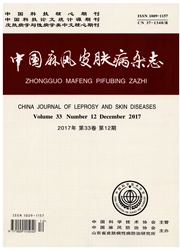

 中文摘要:
中文摘要:
目的:构建昆明鼠皮肤光老化小鼠模型。方法:采用模拟日光组分的紫外线照射昆明小鼠,初始照射剂量为最小红斑量,剂量周递增。然后进行照射组和对照组小鼠皮肤大体形态参数和组织学特征比较,进而从分子水平比较丙二醛产物水平和p53表达水平。结果:照射小鼠皮肤厚度为0.0507±0.0082em较对照小鼠皮肤0.0397±0.0063 cm厚(P〈0.05);照射组皮肤皱纹评分较对照组增高(P〈0.05);组织学特征分析发现照射组小鼠皮肤出现显著的胶原纤维和弹力纤维光老化组织学特征。照射组小鼠皮肤丙二醛水平和p53表达显著升高。结论:皮肤光老化小鼠模型的建立为皮肤光老化的研究提供了可用的模型。
 英文摘要:
英文摘要:
Objective: To construct a mice model for skin photo-aging. Methods: The Kunming mice were irradiated by ultraviolet-simulated solar light. The irradiation of ultraviolet began with minimum erythema dose and the dose was increased per week. When the irradiation was finished, the irradiated mice and controls were measured and analyzed for parameters of skin appearance and histological characters. Additionally, the level of malondialdehyde and expression of p53 protein were detected by biological method and immunohisto- chemistry respectively. Results: The skin thickness was thicker in irradiated mice (0.0507±0.0082 cm) than in controls (0.0397±0.0063 cm, P〈0.05 ). The skin wrinkle scores was higher in irradiated mice than in con- trois (P〈0.05). Histological analysis indicated that the skin of irradiated mice presented significant photo-ag- ing changes of collagen and elastic fibers. The level of malondialdehyde and p53 protein expression was signifi- cantly up-regulated in irradiated mice. Conclusion: The successful construction of mice model provides with a useful model in the field of photo-aging study.
 同期刊论文项目
同期刊论文项目
 同项目期刊论文
同项目期刊论文
 期刊信息
期刊信息
